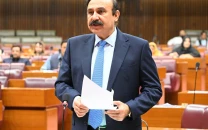JIT didn’t have ‘reliable data’ on cash flow: Zia
Says probe panel got HME financial statement through a ‘source document’

PHOTO: REUTERS/FILE
The JIT head Wajid Zia also admitted that cash flow statement was never put to Sharif’s son, Hussain Nawaz, when he was probed by the JIT members, adding that the cash flow statement was never discussed in the JIT report either.
To this revelation, the counsel for the jailed PM, Khawaja Haris, drew the court’s attention to his question wherein, he said, he only asked about ‘any data’ and not about ‘reliable data’.
Adiala officials deny knowledge of Sharif offer
To a question if the witness collected data regarding the cash generated by the HME during any period of any financial year, Zia said the JIT got the cash flow statement which showed the cash generated for the period of January to July 2011 through ‘a sourced document’.
The details emerged from the cross examination of Zia in the National Accountability Bureau’s (NAB) Al-Azizia & Hill Metal Establishment reference filed against Sharif and his two sons, Hussain and Hassan.’
Both the brothers have already been declared proclaimed offenders in the London flats reference after they failed to appear before the court to face the reference. For the sixth time, Nawaz Sharif was presented before the accountability court.
Sharif, his daughter Maryam and son in-law Captain (retd) Safdar are currently incarcerated in Adiala Jail as they were convicted in NAB’s Avenfield Apartments reference on July 6. The court sentenced Sharif to 10-year, Maryam to seven-year and Safdar to two-year imprisonment.
Sharif corruption references hearing adjourned
At one point, Haris enquired of Zia if he could tell whether cash flow could be determined if one has the net profit of a company in a financial year. Zia replied” “I can’t answer about any formula.”
When Haris insisted, Zia said he could not tell if cash flow of a company can be concluded on the basis of the amount of net profit after tax, amount of depreciation and amortisation of a commercial business for any particular period of a financial year.
He voluntarily explained that different accounting methods are used in different jurisdictions and the auditing companies preparing accounts can answer the question.
Haris asked him if he could tell about any of the methods. “I can’t specify any method,” he replied and voluntarily explained that its highly technical subject and the JIT did not divulge into such details.
The first hour of the cross examination was consumed in arguments of Haris and NAB’s prosecutor, Wasiq Malik, when the latter objected to the first question posed to Zia.
The question was: Is it correct that for the purpose of calculating net cash flow of a business in any given year where the net profit, loss or income has been ascertained, the value of non-cash items such as depreciation, amortisation for the relevant years are added to the amount of net profit, loss or income for the said year?
Malik objected that the question was irrelevant and the JIT only discussed cash flow as one of the ingredients, adding whatever the conclusions and findings are drawn were on the basis of available figures on net profits of the HME. Haris argued that under the law defence counsel can even ask about the things the witness has not disclosed in his statement, adding he was only asking relevant questions.
The judge adjourned the case till Aug 30 (today) when Haris would resume cross examination.



















COMMENTS
Comments are moderated and generally will be posted if they are on-topic and not abusive.
For more information, please see our Comments FAQ